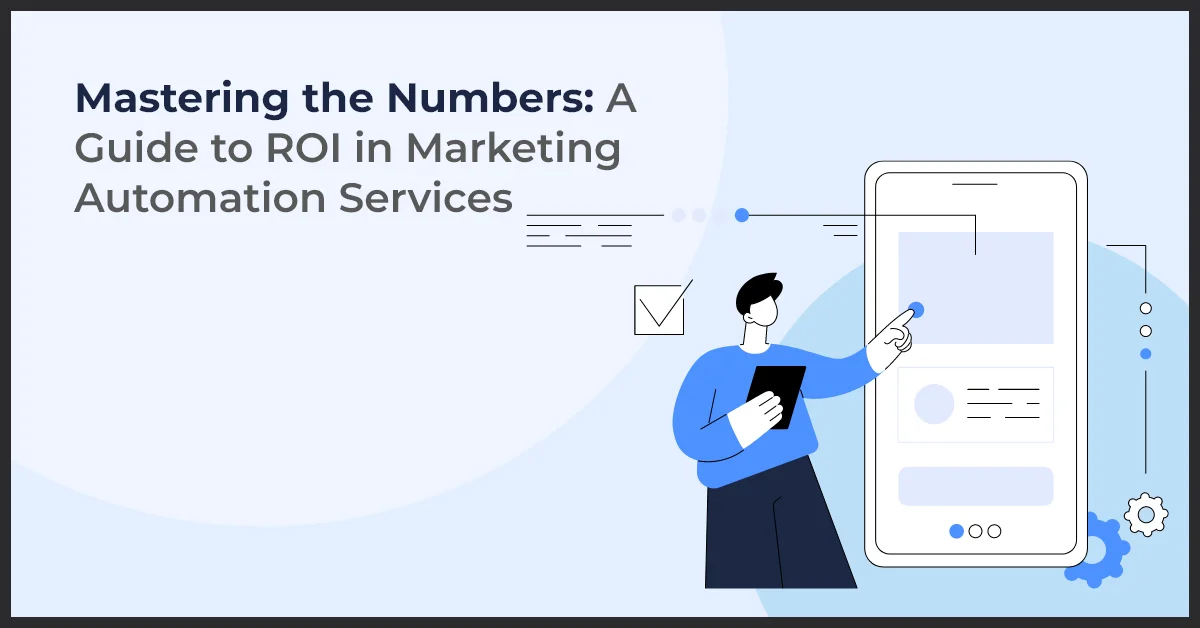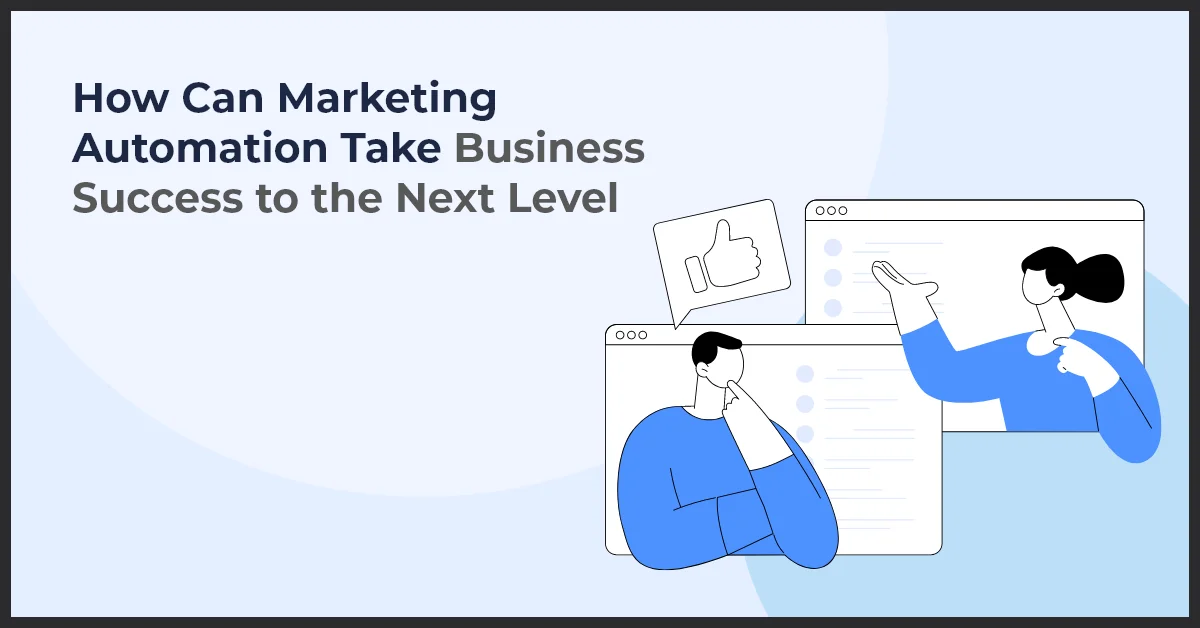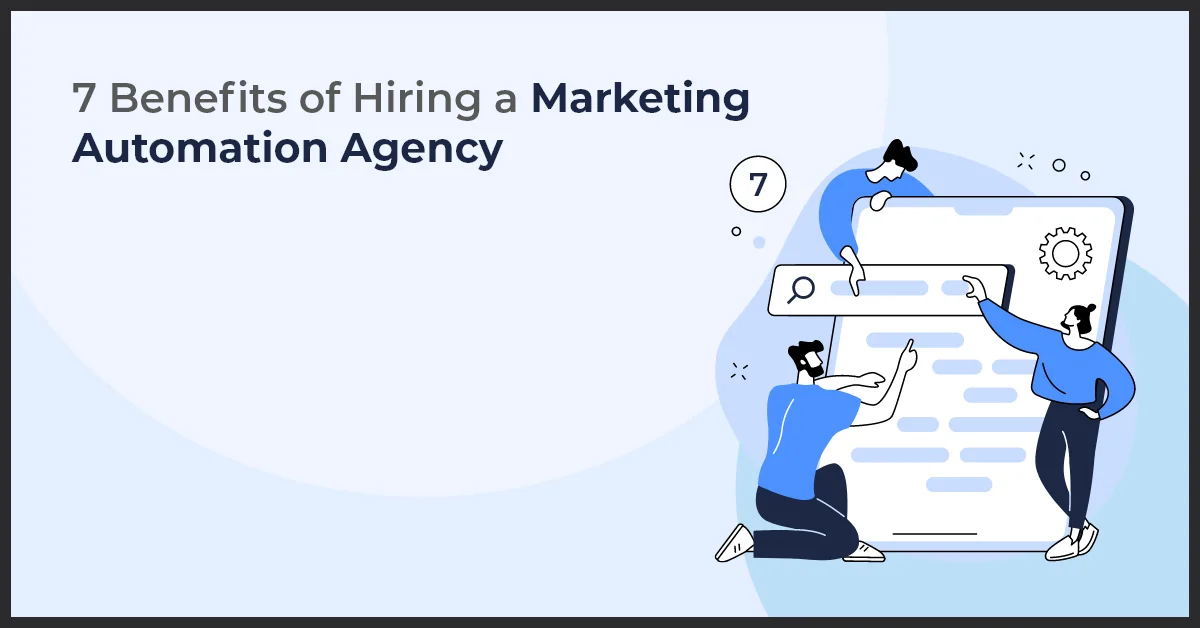Mastering the Numbers: A Guide to ROI in Marketing Automation Services

Published on: May 17, 2023
Updated on: July 08, 2024
601 Views
- Marketing Automation
12 min read
Introduction
In the ever-evolving world of B2B marketing, automation has emerged as a significant game-changer. Marketing automation services can drive efficiency, enhance customer engagement, and boost revenue. However, to truly appreciate its value and to guide strategic decisions, it's essential to understand the return on investment (ROI) derived from these services.
But like any investment, the key question is, "How do we measure marketing automation ROI (Return on Investment) ?"
Defining the ROI of your marketing automation efforts can be daunting. It requires measuring many metrics and making sense of copious amounts of data. But fear not. In this blog post, we'll break down the process into manageable steps to help you accurately measure and maximize your marketing automation ROI.
What Is Marketing Automation ROI?
Marketing automation ROI is a measurement of the financial return your business gains from the investment it makes in marketing automation services. It's a way to quantify the effectiveness of these services in achieving your business goals, whether generating leads, retaining customers, or driving revenue.
Let's consider an example of a B2B company that sells cloud-based project management software. They have implemented a marketing automation platform to improve their lead generation and customer acquisition efforts.
Before implementing the marketing automation platform, the company's marketing expenses were as follows:
Marketing team salaries: $100,000 per year
Other marketing costs (ads, events, etc.): $50,000 per year
Total marketing costs: $150,000 per year
After implementing the marketing automation platform, their costs increased due to the platform subscription and training:
Marketing automation platform subscription: $20,000 per year
Training for the marketing team: $5,000
New total marketing costs: $175,000 per year
In the first year of using the marketing automation platform, the company was able to generate 1000 new leads, and they converted 10% of those leads into customers. Their average revenue per customer is $1,000.
So, their total revenue from the new customers acquired through the marketing automation platform is:
New customers: 100 (10% of 1000 leads)
Total revenue: $100,000 (100 customers * $1,000 per customer)
To calculate their Marketing automation ROI, they would subtract the total marketing costs from the total revenue, divide by the total marketing costs, and then multiply by 100 to get a percentage:
ROI = [(Total Revenue - Total Marketing Costs) / Total Marketing Costs] * 100
ROI = [($100,000 - $175,000) / $175,000] * 100
ROI = -42.86%
In this example, the company's marketing automation ROI in the first year is negative, which means it didn't recoup its investment in the marketing automation platform. However, it's important to note that it often takes time to see the full benefits of marketing automation, and many of the costs (like the platform subscription and training) are upfront costs that won't recur yearly.
Over time, as the company continues to generate and convert leads through the marketing automation platform, its ROI should improve. To boost its Marketing automation ROI, it can also work on improving its lead conversion rate and increasing its revenue per customer.
Importance of Measuring Marketing Automation ROI
In the realm of marketing automation, it's crucial to keep a keen eye on the return on investment (ROI). Marketing automation ROI is not merely a financial metric; it's a key performance indicator that offers insights into the efficiency and effectiveness of your marketing strategies. Here's why measuring Marketing automation ROI is so essential:
- Justifying the Investment: Marketing automation services often require significant investment, both in terms of financial cost and time. It includes the cost of the platform itself, training staff to use it, and ongoing management. By calculating the ROI, you can demonstrate the value of this investment. For instance, if your marketing automation efforts lead to a 20% increase in lead generation or a 30% increase in customer retention, these tangible results can justify the initial and ongoing investment.
- Informing Future Strategies: Marketing automation ROI doesn't just provide a snapshot of your past or current performance. It can also be a powerful tool for informing future strategies. By understanding which aspects of your marketing automation services are delivering the highest ROI, you can focus more on those areas in the future. For example, if your email automation campaigns are generating a higher ROI than your social media campaigns, you might decide to invest more resources into refining and expanding your email strategy.
- Allocating Resources Effectively: Limited resources are a common challenge in business. Measuring Marketing automation ROI can help you allocate these resources more effectively by highlighting the areas that deliver the most value. Suppose you're using several marketing automation features like email marketing, social media scheduling, and customer segmentation. If your ROI analysis shows that customer segmentation is delivering the most value, you might decide to allocate more resources (like time, budget, and staff) to this area.
- Identifying Areas for Improvement: Marketing automation ROI is not just about identifying success; it's also about highlighting areas for improvement. If certain marketing automation strategies are not delivering a positive ROI, it could indicate that these strategies need to be refined or replaced. For example, if your automated social media posts are not generating enough engagement or leads to justify the investment, it might be time to revisit your social media strategy.
- Proving Value to Stakeholders: Lastly, Marketing automation ROI is a universally recognized metric that you can use to demonstrate the value of your marketing automation efforts to stakeholders. It could be particularly important if you need to secure additional budget or resources for your marketing automation services.
Key Metrics to Track for Measuring Marketing Automation ROI
The metrics you track will depend on your specific goals. Here are some common categories and key metrics within them:
Lead Generation Metrics:
These are crucial for businesses focused on acquiring new customers.
- Conversion rate: The percentage of leads that convert into customers.
- Cost per lead: The total cost of your marketing efforts divided by the number of leads generated.
- Marketing qualified leads (MQLs): Leads that marketing teams have deemed likely to become customers, based on predefined criteria.
- Sales qualified leads (SQLs): Leads that sales teams have identified as being ready for the sales process.
Customer Retention Metrics:
These are vital for businesses focusing on retaining and growing their existing customer base.
- Churn rate: The percentage of customers who stop doing business with you during a given period.
- Customer lifetime value (CLV): The total revenue you can expect from a customer over the course of their relationship with your business.
- Net Promoter Score (NPS): A measure of customer loyalty, indicating how likely customers are to recommend your business to others.
Revenue Metrics:
These directly indicate the financial performance of your marketing efforts.
- Total revenue: The total income generated from your marketing efforts.
- Return on Investment (ROI): The net profit from your marketing automation efforts divided by the total cost of those efforts.
- Cost per acquisition (CPA): The total cost of acquiring a new customer.
Steps to Measuring Marketing Automation ROI
Define Your Goals
Before diving into calculations and analytics, define what success means for your business. What are the specific goals you want to achieve with marketing automation? Your objectives might range from generating more leads, increasing sales, and improving customer retention to enhancing customer lifetime value.
Identify Key Performance Indicators (KPIs)
Once you've defined your goals, the next step is to establish the KPIs that align with these objectives. For instance, if your goal is to generate more leads, your KPI could be the number of new leads acquired per month. Similarly, if improving customer retention is your target, the churn rate might be your KPI. Other common KPIs include conversion rates, email open rates, click-through rates, and sales revenue.
Track Your Investment
To calculate Marketing automation ROI, you need to know how much you're investing in your marketing automation. It goes beyond the cost of the software itself. Consider expenses like training costs, the time spent by your team managing and strategizing the campaigns, and any third-party fees associated with the automation efforts.
Measure Your Returns
The "returns" in your Marketing automation ROI calculation will be derived from the goals you initially set. If your goal were to generate leads, your return would be an increase in the number of leads. If it were to enhance customer lifetime value, your return would increase the average customer lifetime value. You can typically find these numbers in your marketing automation software's analytics dashboard.
Calculate Your Marketing Automation ROI
Now that you have your investment and returns, you can calculate your ROI. The formula is:
ROI = (Net Profit / Cost of Investment) * 100%
The Net Profit is your returns minus your investment.
Monitor and Optimize
The process doesn't stop once you've calculated your ROI. It's essential to continuously monitor your metrics and optimize your marketing automation strategy. For example, if your emails aren't generating the expected results, A/B testing different subject lines or content could improve their effectiveness.
Ultimately, the Marketing automation ROI isn't just about numbers. It's about understanding how automation is improving your marketing efficiency and effectiveness, freeing up your team to focus on strategic tasks, and helping drive business growth. By consistently measuring and optimizing your marketing automation efforts, you can ensure your investment pays off in the long run.
Pro Tip: When calculating marketing automation ROI, ensure that all relevant expenses, beyond the cost of the software, are included, such as training costs, team time spent, and any third-party fees. This comprehensive approach provides a more accurate representation of your investment and its returns.
Ways to Maximize Your Marketing Automation ROI
Maximizing your marketing automation ROI often involves refining your strategy based on your metric analysis. It might mean focusing more on the channels that generate the most leads, personalizing your marketing messages to increase conversion rates, or investing in customer satisfaction initiatives to boost retention and CLV.
Challenges in Measuring Marketing Automation ROI
Measuring Marketing automation ROI, though crucial, can sometimes be a complex endeavor. Several challenges can complicate the process:
Difficulty in Tracking Customer Behavior: Customers interact with your business through multiple touchpoints - emails, social media, your website, and more. Tracking these interactions accurately to attribute them to specific marketing automation efforts can be challenging. The customer journey is rarely linear, and comprehending the cumulative impact of various touch points requires sophisticated tracking and attribution models.
- Inaccurate Data: The accuracy of your Marketing automation ROI calculation is only as good as the data you base it on. If the data you're collecting is erroneous, incomplete, or outdated, it can lead to skewed results. It may be due to issues like software glitches, data entry errors, or failure to update customer information.
- Over-reliance on Technology: While technology is at the heart of marketing automation, an over-reliance on it can be detrimental. It’s important to remember that technology is a tool and not a strategy in itself. Also, while automation tools can provide valuable insights, they may not account for external factors influencing your business, like changes in the market or competitive landscape.
- Incomplete Data: With marketing automation, you have access to a plethora of data. However, you might not be capturing or analyzing all the data points that could provide valuable insights. For instance, you might be tracking email open rates but neglecting to analyze click-through rates, which could give a better indication of customer engagement.
Pro Tip: Overcome challenges in measuring marketing automation ROI by implementing robust tracking and attribution models to accurately attribute customer interactions to specific marketing efforts. Additionally, ensure data accuracy by regularly updating and verifying your data sources to minimize errors and maximize the reliability of your ROI calculations.
Key Takeaways
- Understanding and measuring marketing automation ROI is essential as it provides insights into the efficiency and effectiveness of your strategies, justifies investments, informs future strategies, and helps allocate resources effectively.
- It is crucial to track metrics such as lead generation, customer retention, and revenue. Metrics like conversion rate, churn rate, and ROI directly reflect marketing automation efforts' performance and financial impact.
- Defining goals, identifying key performance indicators (KPIs), tracking investments, measuring returns, and calculating ROI is fundamental to assessing marketing automation ROI. Continuous monitoring and optimization are necessary for ongoing success.
- Maximizing marketing automation ROI involves refining strategies based on metric analysis, focusing on high-performing channels, personalizing messages, and investing in initiatives to enhance customer satisfaction and retention.
Conclusion
Marketing automation services can yield significant benefits, from improved efficiency to enhanced customer engagement and revenue growth. Understanding and accurately measuring the marketing automation ROI is crucial to validating its effectiveness, guiding strategic decisions, and maximizing its value.
Despite the challenges associated with measuring ROI, it’s an invaluable process. By defining clear objectives, tracking the right metrics, continuously analyzing and adjusting your strategy, and addressing the challenges head-on, you can better comprehend your marketing automation ROI and utilize these insights for improved results.
In the end, the most powerful marketing automation strategy is one that’s flexible, data-driven, and customer-focused. Remember, the tools are there to aid you, but your unique business goals and the needs of your customers should always lead your strategy.
Whether you plan to implement these strategies in-house or seek professional assistance at info@growthnatives.com or call +1 855-693-4769, the journey begins with a commitment to harnessing the power of marketing automation. If it's the latter, we are here to help. Contact us today, embrace the data-driven, automated approach, and watch your business thrive in the years to come.
Frequently Asked Questions
The ROI of marketing automation refers to the financial return a business gains from investing in marketing automation services.
To calculate ROI for an automation project, subtract the total costs associated with the project from its total revenue. Then, divide this difference by the total costs and multiply by 100 to get a percentage.
Marketing automation is important because it streamlines marketing processes, enhances efficiency, improves customer engagement, and ultimately boosts revenue by automating repetitive tasks and delivering personalized experiences at scale.
Marketing automation in AI refers to using artificial intelligence (AI) technologies to automate and optimize marketing tasks such as lead scoring, personalized content delivery, predictive analytics, and customer segmentation.
Businesses can use marketing automation platforms to automate repetitive tasks, segment their audience, personalize content, send targeted emails, nurture leads, track customer behavior, and analyze campaign performance.
A good ROI in marketing varies depending on industry, business size, and specific goals. Generally, a positive ROI that exceeds the investment cost is considered good, but the ideal ROI percentage can differ based on individual circumstances.
A good ROI for a business typically exceeds the industry average and meets or exceeds the company’s financial objectives. It varies depending on factors such as industry, investment type, and business goals, but generally, a 10% or higher ROI is considered satisfactory.



